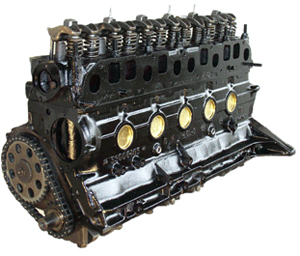o the center of the bearing register. Two additional bolt bosses added to block where fuel pump would sit (lower right front) for coil mount.

1996-1998
C/N 3010341, 53010449
Cast iron block, left side has five 2" cast plugs. Second bolt from pan rail on right side of timing cover is a through hole, coil mount bosses lower right front. Basically it is the same as the 1991-’95 blocks except for dowel pins in the deck for head and block alignment. Oil filter mounting on left side of block is pointing downward. Uses long main bolts and stud girdle. Has "NVH" on side to denote block strengthened for "noise, vibration and harshness" reductions (no visible differences).
1998
C/N 53020514, 53020515
Cast iron block, oil filter mounting surface is 90° to pan rail of engine instead of pointing downward. Uses long main bolts and stud girdle. Has 1/8˝ pipe thread oil tap into main oil line in rear of block. Will retro back with filter kit available from Daimler-Chrysler. Has "NVH" on side to denote block strengthened for "noise, vibration and harshness." Grand Cherokee application.
1999-2006
C/N 53010327AB, 53010328AB
Cast iron block, oil filter mounting surface is 90° to pan rail of engine instead of pointing downward. All kinds of configuration and boss changes with long mounting boss protruding off the lower left of block. Uses long main bolts and stud girdle. Camshaft thrust plate block. Has "NVH" on side to denote block strengthened for "noise, vibration and harshness." No coil pack mount bosses, now mounted on cylinder head.
1999-2001
C/N 53010449AA
Cast iron block, second bolt from pan rail on right side of timing cover is a through hole. Oil filter mounting on left side of block is pointing downward. Uses long main bolts and stud girdle. Basically the same as 1996-1998 except that it is a camshaft thrust plate block. Has "NVH" on side to denote block strengthened for "noise, vibration and harshness."
Article courtesy of ENGINE BUILDER magazine.













